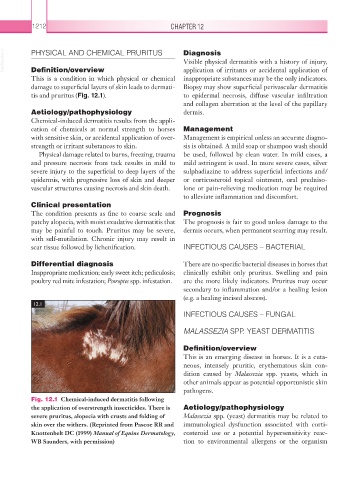Page 1237 - Equine Clinical Medicine, Surgery and Reproduction, 2nd Edition
P. 1237
1212 CHAPTER 12
VetBooks.ir PHYSICAL AND CHEMICAL PRURITUS Diagnosis
Visible physical dermatitis with a history of injury,
Definition/overview
inappropriate substances may be the only indicators.
This is a condition in which physical or chemical application of irritants or accidental application of
damage to superficial layers of skin leads to dermati- Biopsy may show superficial perivascular dermatitis
tis and pruritus (Fig. 12.1). to epidermal necrosis, diffuse vascular infiltration
and collagen aberration at the level of the papillary
Aetiology/pathophysiology dermis.
Chemical-induced dermatitis results from the appli-
cation of chemicals at normal strength to horses Management
with sensitive skin, or accidental application of over- Management is empirical unless an accurate diagno-
strength or irritant substances to skin. sis is obtained. A mild soap or shampoo wash should
Physical damage related to burns, freezing, trauma be used, followed by clean water. In mild cases, a
and pressure necrosis from tack results in mild to mild astringent is used. In more severe cases, silver
severe injury to the superficial to deep layers of the sulphadiazine to address superficial infections and/
epidermis, with progressive loss of skin and deeper or corticosteroid topical ointment, oral predniso-
vascular structures causing necrosis and skin death. lone or pain-relieving medication may be required
to alleviate inflammation and discomfort.
Clinical presentation
The condition presents as fine to coarse scale and Prognosis
patchy alopecia, with moist exudative dermatitis that The prognosis is fair to good unless damage to the
may be painful to touch. Pruritus may be severe, dermis occurs, when permanent scarring may result.
with self-mutilation. Chronic injury may result in
scar tissue followed by lichenification. INFECTIOUS CAUSES – BACTERIAL
Differential diagnosis There are no specific bacterial diseases in horses that
Inappropriate medication; early sweet itch; pediculosis; clinically exhibit only pruritus. Swelling and pain
poultry red mite infestation; Psoroptes spp. infestation. are the more likely indicators. Pruritus may occur
secondary to inflammation and/or a healing lesion
(e.g. a healing incised abscess).
12.1
INFECTIOUS CAUSES – FUNGAL
MALASSEZIA SPP. YEAST DERMATITIS
Definition/overview
This is an emerging disease in horses. It is a cuta-
neous, intensely pruritic, erythematous skin con-
dition caused by Malassezia spp. yeasts, which in
other animals appear as potential opportunistic skin
pathogens.
Fig. 12.1 Chemical-induced dermatitis following
the application of overstrength insecticides. There is Aetiology/pathophysiology
severe pruritus, alopecia with crusts and folding of Malassezia spp. (yeast) dermatitis may be related to
skin over the withers. (Reprinted from Pascoe RR and immunological dysfunction associated with corti-
Knottenbelt DC (1999) Manual of Equine Dermatology, costeroid use or a potential hypersensitivity reac-
WB Saunders, with permission) tion to environmental allergens or the organism

